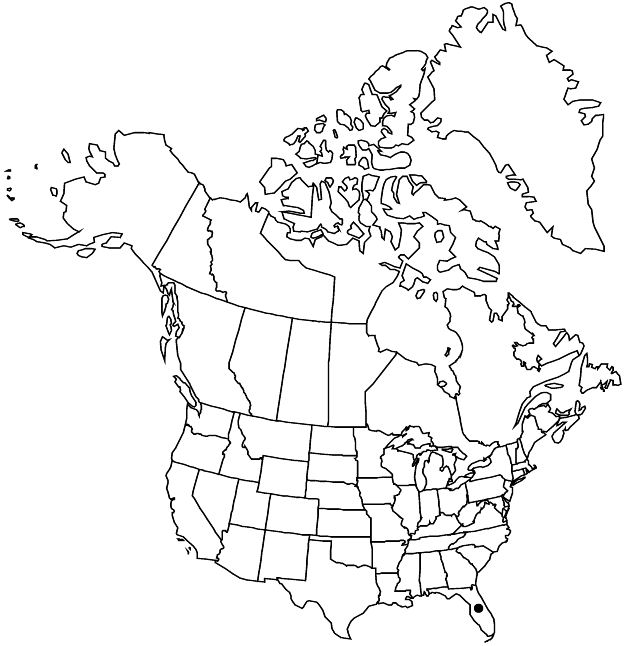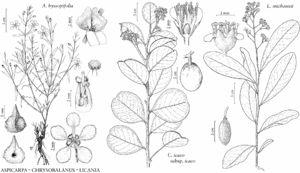Difference between revisions of "Chrysobalanus icaco subsp. icaco"
FNA>Volume Importer |
imported>Volume Importer |
||
| (6 intermediate revisions by 2 users not shown) | |||
| Line 1: | Line 1: | ||
{{Treatment/ID | {{Treatment/ID | ||
|accepted_name=Chrysobalanus icaco subsp. icaco | |accepted_name=Chrysobalanus icaco subsp. icaco | ||
| − | |accepted_authority= | + | |accepted_authority= |
|publications= | |publications= | ||
|common_names=Coco-plum | |common_names=Coco-plum | ||
|special_status={{Treatment/ID/Special_status | |special_status={{Treatment/ID/Special_status | ||
|code=F | |code=F | ||
| − | |label= | + | |label=Illustrated |
}} | }} | ||
|basionyms= | |basionyms= | ||
| Line 12: | Line 12: | ||
|name=Chrysobalanus interior | |name=Chrysobalanus interior | ||
|authority=Small | |authority=Small | ||
| − | }}{{Treatment/ID/Synonym | + | |rank=species |
| + | }} {{Treatment/ID/Synonym | ||
|name=C. pellocarpus | |name=C. pellocarpus | ||
|authority=G. Meyer | |authority=G. Meyer | ||
| + | |rank=species | ||
}} | }} | ||
|hierarchy=Chrysobalanaceae;Chrysobalanus;Chrysobalanus icaco;Chrysobalanus icaco subsp. icaco | |hierarchy=Chrysobalanaceae;Chrysobalanus;Chrysobalanus icaco;Chrysobalanus icaco subsp. icaco | ||
| Line 30: | Line 32: | ||
|elevation=0–10 m. | |elevation=0–10 m. | ||
|distribution=Fla.;Mexico;West Indies;Central America;e South America;introduced in Pacific Islands. | |distribution=Fla.;Mexico;West Indies;Central America;e South America;introduced in Pacific Islands. | ||
| − | |discussion=<p>Chrysobalanus icaco is known in the flora area only from southern Florida. Leaf morphology varies widely and has prompted a proliferation of names for this taxon. The fruits are eaten, and their flavor varies from a taste of marshmallow to apple; they have folk medicinal value in tropical areas. Although preserved as a foodstuff and used as an ornamental, the species has little current economic value in Florida; it is being investigated for cultivation there as a tropical fruit.</p> | + | |discussion=<p><i>Chrysobalanus icaco</i> is known in the flora area only from southern Florida. Leaf morphology varies widely and has prompted a proliferation of names for this taxon. The fruits are eaten, and their flavor varies from a taste of marshmallow to apple; they have folk medicinal value in tropical areas. Although preserved as a foodstuff and used as an ornamental, the species has little current economic value in Florida; it is being investigated for cultivation there as a tropical fruit.</p> |
|tables= | |tables= | ||
|references= | |references= | ||
| Line 39: | Line 41: | ||
-->{{#Taxon: | -->{{#Taxon: | ||
name=Chrysobalanus icaco subsp. icaco | name=Chrysobalanus icaco subsp. icaco | ||
| − | + | |authority= | |
| − | |authority= | ||
|rank=subspecies | |rank=subspecies | ||
|parent rank=species | |parent rank=species | ||
| Line 53: | Line 54: | ||
|publication title= | |publication title= | ||
|publication year= | |publication year= | ||
| − | |special status= | + | |special status=Illustrated |
| − | |source xml=https:// | + | |source xml=https://bitbucket.org/aafc-mbb/fna-data-curation/src/2e0870ddd59836b60bcf96646a41e87ea5a5943a/coarse_grained_fna_xml/V12/V12_658.xml |
|genus=Chrysobalanus | |genus=Chrysobalanus | ||
|species=Chrysobalanus icaco | |species=Chrysobalanus icaco | ||
Latest revision as of 20:16, 5 November 2020
Shrubs or trees 1–5 m; stems usually arising singly. Twigs reddish, glabrate, lenticels elliptic, pith tan; bark striate. Leaves: stipules ovate, 0.8–2.5 mm; petiole 2–3 mm; blade broadly elliptic, broadly ovate or broadly obovate, 3.5–6 × 3–5 cm, length 1.2–1.5 times width, base cuneate, obtuse, or rounded, margins revolute, apex emarginate, rounded or obtuse, surfaces glabrescent except for scattered hairs along midvein. Thyrses: rachis densely hairy; bracteoles caducous, sessile, ovate, 1.5 mm. Flowers: hypanthium 2.5–3 mm; sepals ovate to triangular, 1 mm, both surfaces densely strigose; petals white, spatulate to narrowly spatulate, 3.5–4 mm, glabrous, margins erose, apex obtuse. Drupes white, yellow-green, pink, red, dark purple, or black, (1.2–)1.5–2(–2.5) cm; endocarp 6-ribbed with secondary ribs. 2n = 22.
Phenology: Flowering year-round.
Habitat: Hammocks, beaches, frequently calcareous (shelly) sands.
Elevation: 0–10 m.
Distribution

Fla., Mexico, West Indies, Central America, e South America, introduced in Pacific Islands.
Discussion
Chrysobalanus icaco is known in the flora area only from southern Florida. Leaf morphology varies widely and has prompted a proliferation of names for this taxon. The fruits are eaten, and their flavor varies from a taste of marshmallow to apple; they have folk medicinal value in tropical areas. Although preserved as a foodstuff and used as an ornamental, the species has little current economic value in Florida; it is being investigated for cultivation there as a tropical fruit.
Selected References
None.
